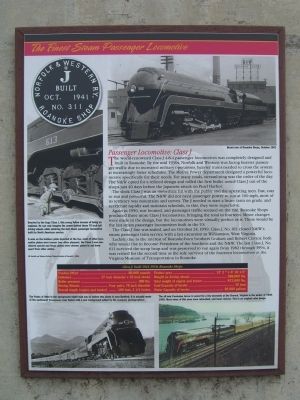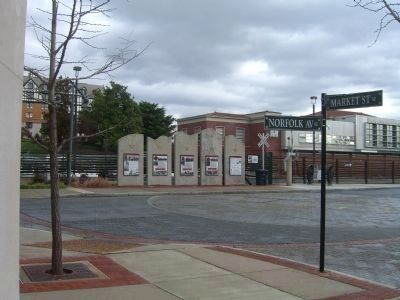Downtown in Roanoke, Virginia — The American South (Mid-Atlantic)
The Finest Steam Passenger Locomotive
The David R. and Susan S. Goode Railwalk
Passenger Locomotive: Class J
The world-renowned Class J 4-8-4 passenger locomotives was completely designed and built in Roanoke. By the mid 1930s, Norfolk and Western was facing heavier passenger traffic due to increased military operations, heavier trains needed to cross the system at increasingly faster schedules. The Motive Power department designed a powerful locomotive specifically for their needs. For many roads, streamlining was the order of the day. The N&W opted for a refined design and rolled the first bullet nosed Class J out of the shops just 40 days before the Japanese attack on Pearl Harbor.
The sleek Class J was an immediate hit with the public and operating men. Fast, easy to run and powerful. The N&W did not need passenger power to run at 100 mph, most of its territory was mountains and curves. The J needed to start a heavy train on grade, and accelerate rapidly and maintain schedule, to this, they were superlative.
Again in 1950, war loomed, and passenger traffic seemed on the rise, Roanoke Shops produced three more Class J locomotives, bringing the total to fourteen. Minor changes were made in the design, but the locomotives were virtually perfect as is. These would be the last steam passenger locomotives built in the US.
The Class J fate was sealed, and on October 24, 1959, Class J, No. 611 closed N&W’s steam passenger train service with a last excursion to Williamson, West Virginia.
Luckily, due to the interest of Roanoke-born brothers Graham and Robert Claytor, both who would rise to become Presidents of the Southern and the N&W. The last Class J, No. 611 survived the scrap heap and was preserved to run again from 1982 through 1994, it was retired for the second time as the sole survivor of the fourteen locomotives at the Virginia Museum of Transportation in Roanoke.
[Table in lower center of marker]
Cylinders: 27 inch diameter x 32 inch stroke
Boiler pressure: 300 lbs.
Driving Wheels: Four pairs, 70 inch diameter
Overall length (engine and tender): 109 foot, 2 ¼ inches
Firebox area: 12’ 2” x 8’ 10 ¼”
Weight on driving wheels: 288,000 lbs.
Total weight of engine and tender: 872,600 lbs.
Coal Capacity of tender: 35 tons
Water Capacity of tender: 20,000 gallons
Erected 2007.
Topics. This historical marker is listed in this topic list: Railroads & Streetcars. A significant historical month for this entry is October 1936.
Location. Marker has been reported permanently removed. It was located
near 37° 16.387′ N, 79° 56.339′ W. Marker was in Roanoke, Virginia. It was in Downtown. Marker was at the intersection of Norfolk Avenue SE and Market Street SE, on the right when traveling west on Norfolk Avenue SE. Touch for map. Marker was in this post office area: Roanoke VA 24011, United States of America.
We have been informed that this sign or monument is no longer there and will not be replaced. This page is an archival view of what was.
Other nearby markers. At least 8 other markers are within walking distance of this location. Roanoke Shops (a few steps from this marker); Today's Rail Traffic (within shouting distance of this marker); Norfolk and Western Passenger Station (within shouting distance of this marker); The Market Square Walkway (within shouting distance of this marker); Hotel Roanoke (within shouting distance of this marker); a different marker also named Hotel Roanoke (about 400 feet away, measured in a direct line); North Jefferson Street (about 500 feet away); Welcome to Historic Roanoke City Market (about 500 feet away). Touch for a list and map of all markers in Roanoke.
More about this marker. All pictures are Norfolk and Western Railway photos provided for the marker from the collection of Kenneth L. Miller. Their captions follow:
[top photo]: Brand new at Roanoke Shops, October 1941
[top left photo]: Dwarfed by the huge Class J, this young fellow dreams of being an engineer. He can only imagine the power behind those 70 inch tall driving wheels while admiring the last steam passenger locomotive built for North American service.
A note on the builders plate depicted at the top, most of other locomotives plates were bronze (see other plaques), the Class J was considered special and those plates were chrome plated to set them apart from other plates.
[lower left photo]: The Peaks of Otter in the background might lead one to believe this photo is near Bedford, it is actually made of the eastbound Tennessean near Salem with a new background added by the company photographers.
[lower right photo]: The all new Powhatan Arrow is posed for a few moments at Dry Branch, Virginia in the winter of 1949-1950. Most views of this pose were retouched, and hand colored. This is an original color image.
Credits. This page was last revised on February 1, 2023. It was originally submitted on January 15, 2009, by Kevin W. of Stafford, Virginia. This page has been viewed 1,259 times since then and 6 times this year. Last updated on February 14, 2021, by Shane Oliver of Richmond, Virginia. Photos: 1, 2. submitted on January 15, 2009, by Kevin W. of Stafford, Virginia. • Bill Pfingsten was the editor who published this page.

